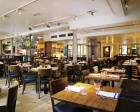Carlo Gavazzi creates a scene in Oxford

The refurbishment of Oxford’s largest restaurant, Quod Brasserie, includes the use of Carlo Gavazzi’s smart building system. It provides this brasserie with the ability to pre-define set scenes, which can be changed through the day in an energy-efficient manner through the integration of lux sensors and dimmers.
The building was a former banking hall before it was transformed by owner Jeremy Mogford into a stylish and contemporary space that houses an amazing collection of young British art.
The system was installed by Simply Advanced, whose Nathan Bayliss explains, ‘The smart building controller which forms the hub of the new system is extremely robust and versatile which is perfect for this type of application
‘For example, it allows the setting of pre-defined functions, which in this case is different lighting scenes that can be used at different times of the day to create the right ambience within the dining area. Once these are created within the central controller, the scenes can be changed by staff at the touch of a button using one of the seven Aurora light switches which have been installed throughout the brasserie.’
The installation is based on Carlo Gavazzi’s Dupline smart-building system using a 2-wire bus. It can be wired using free topology for the cable — including ring, star etc.







